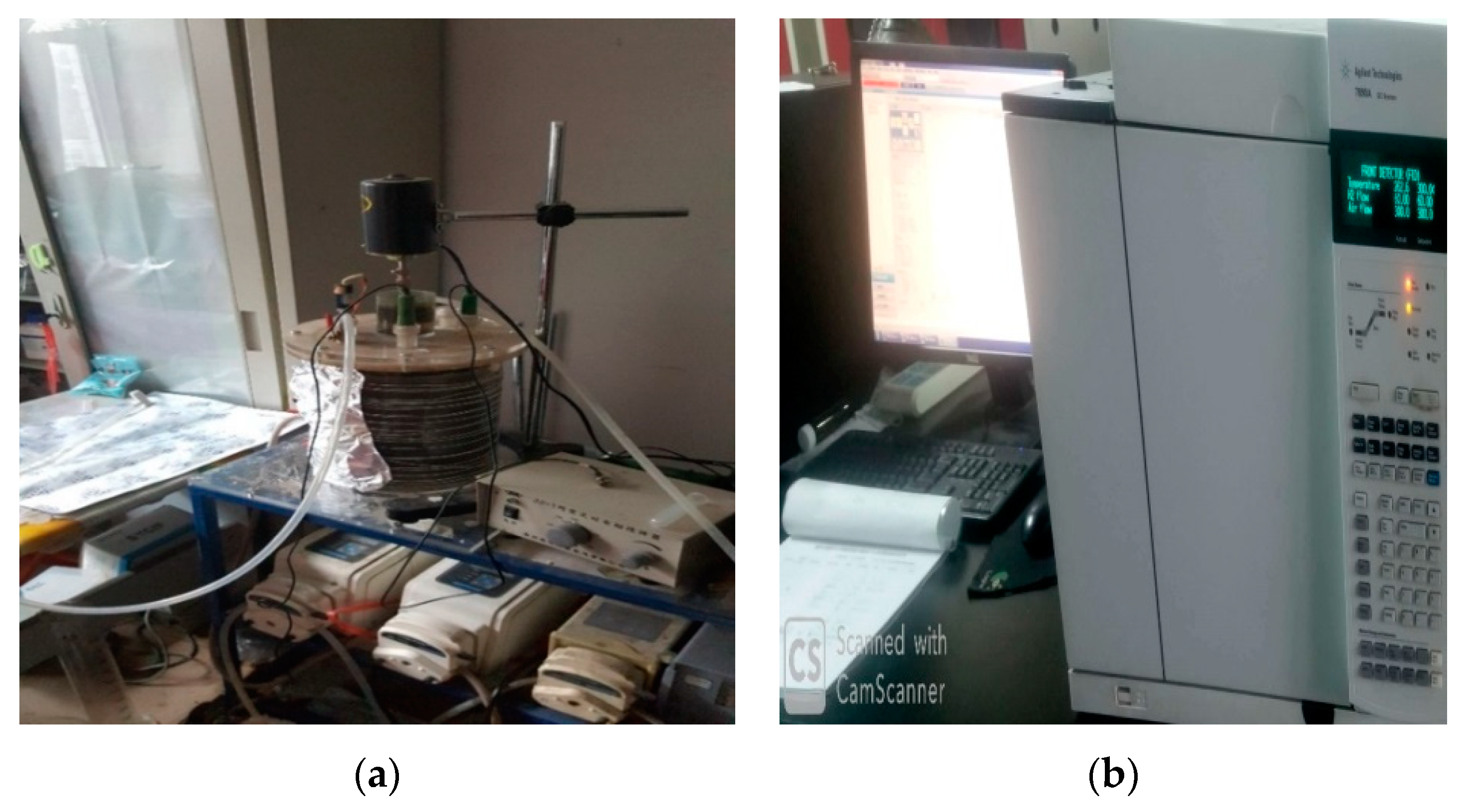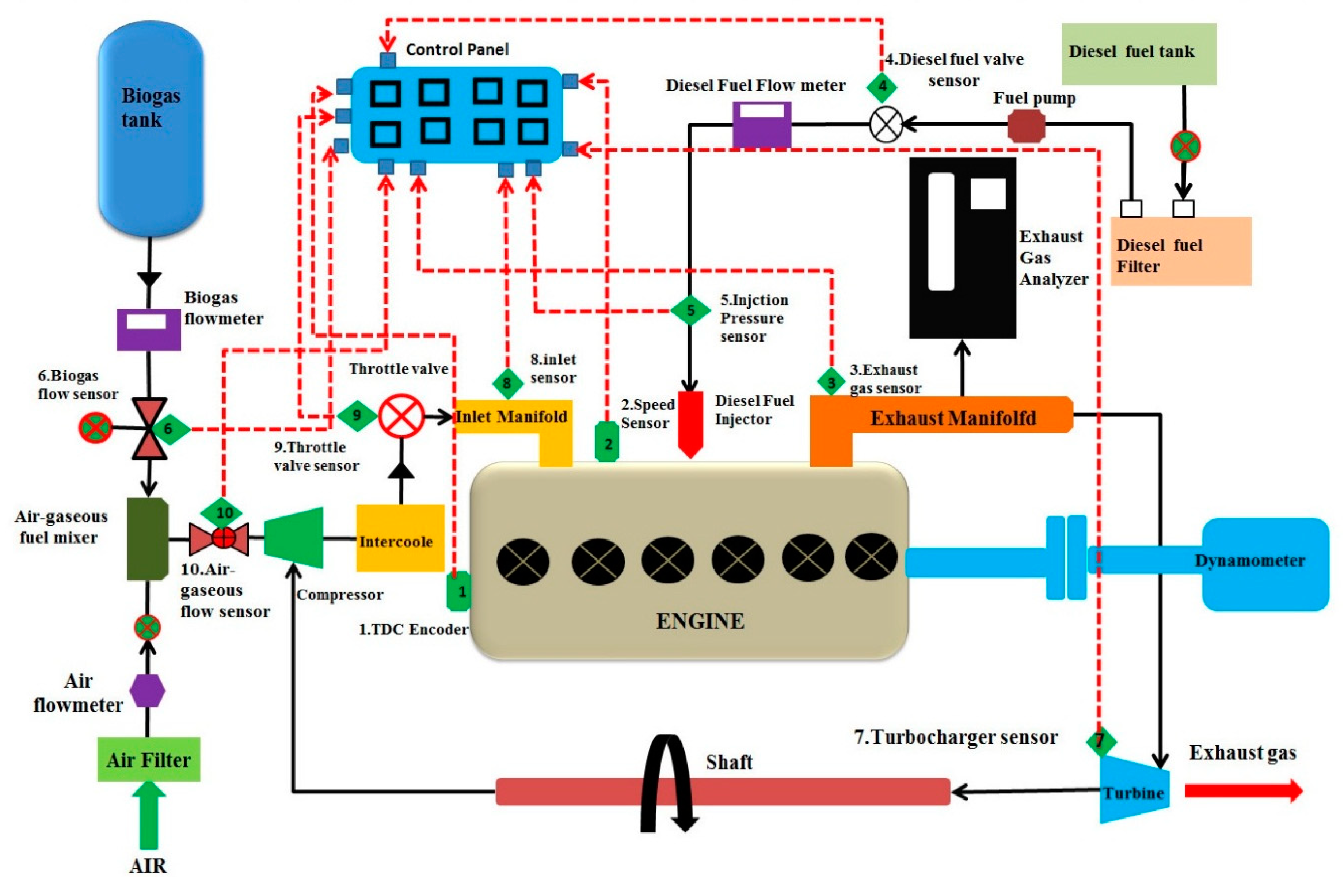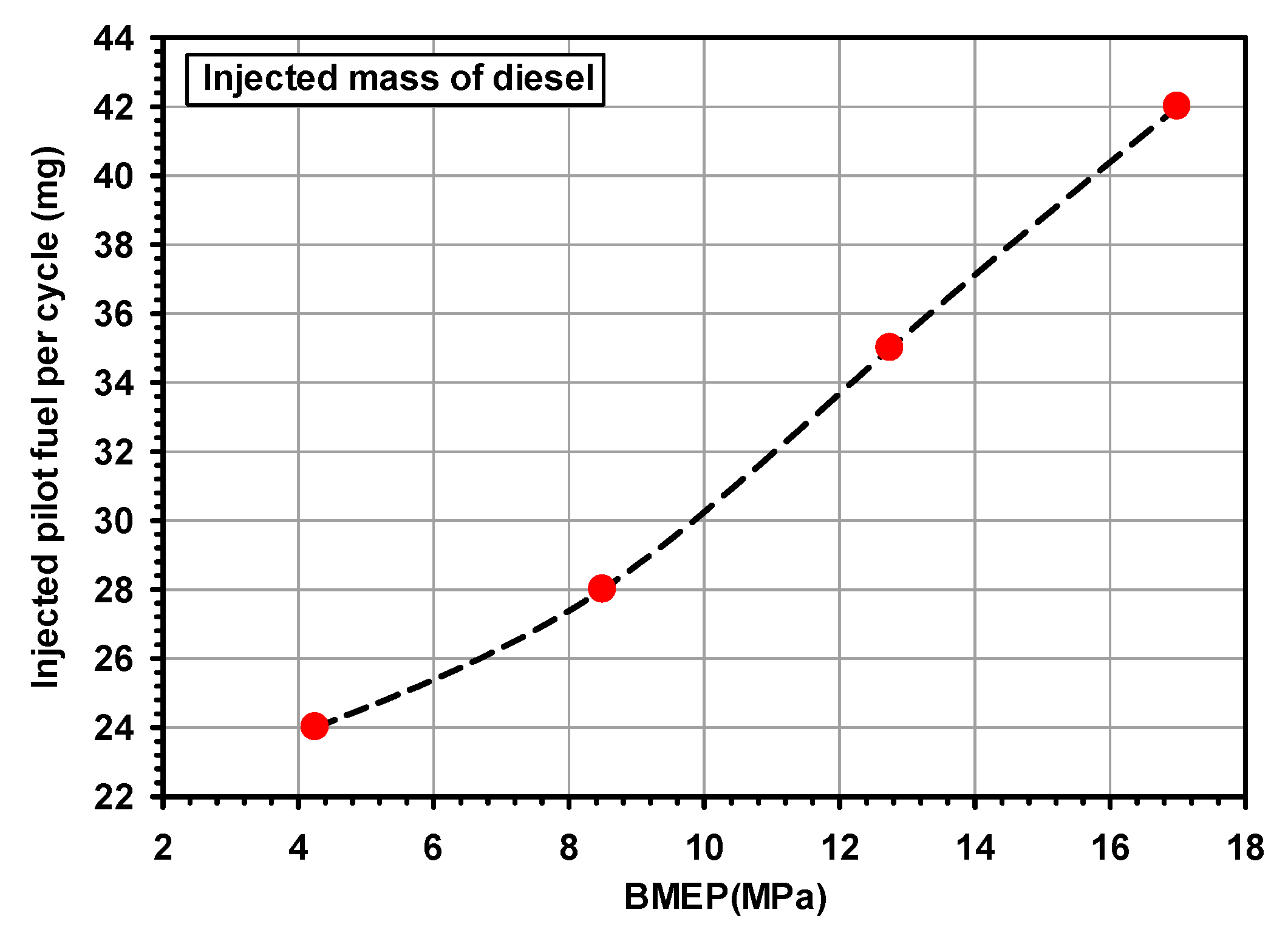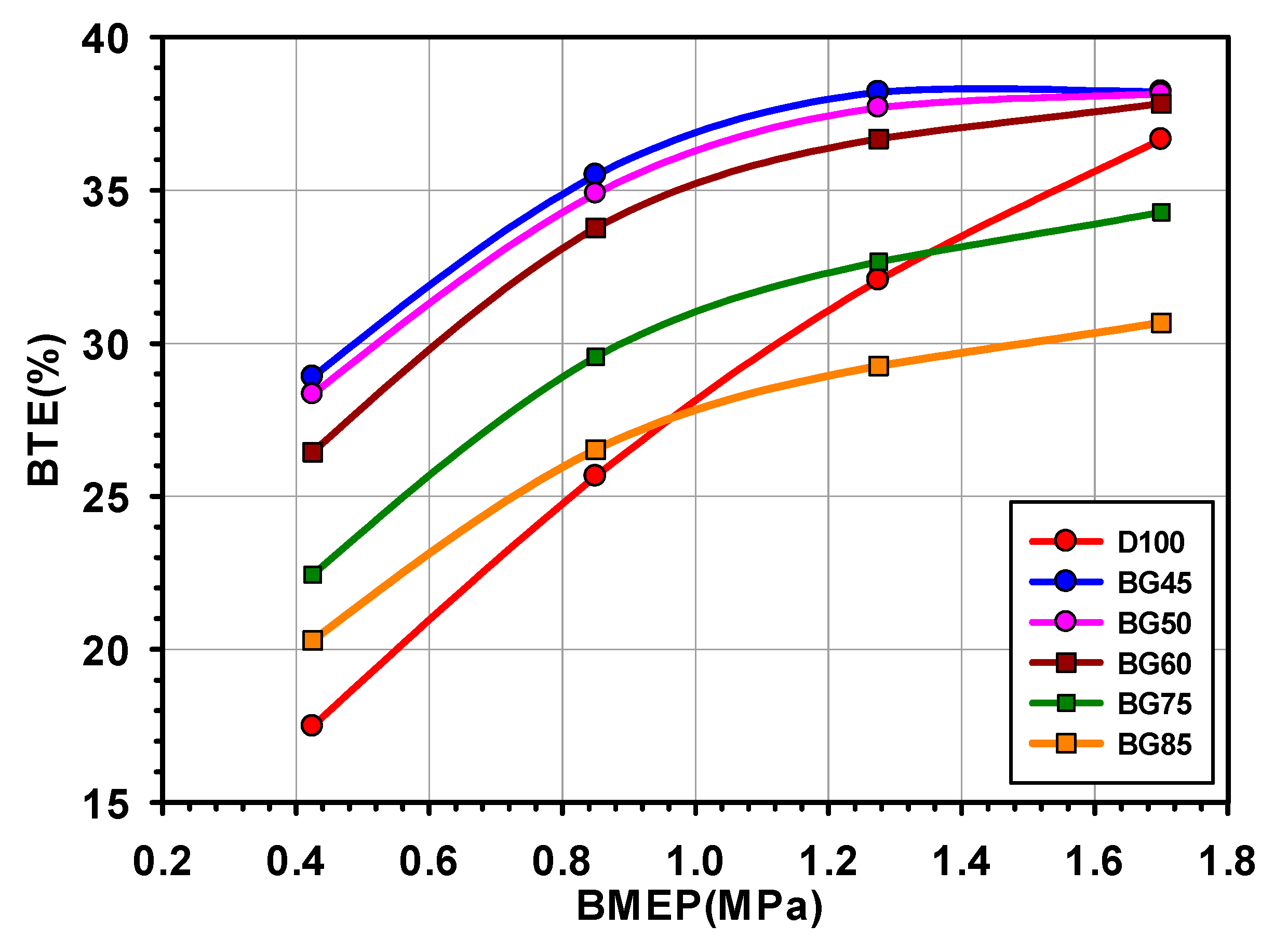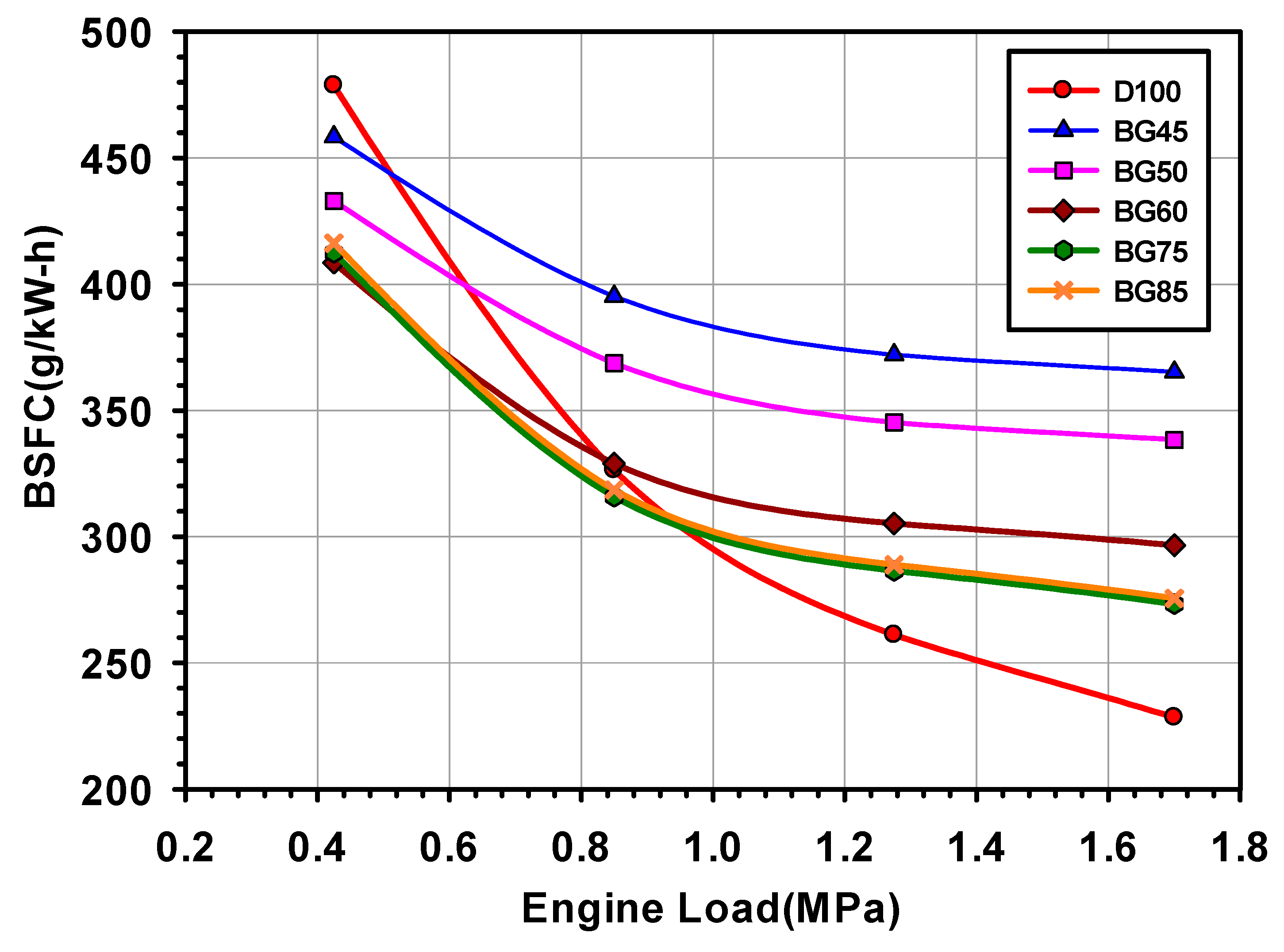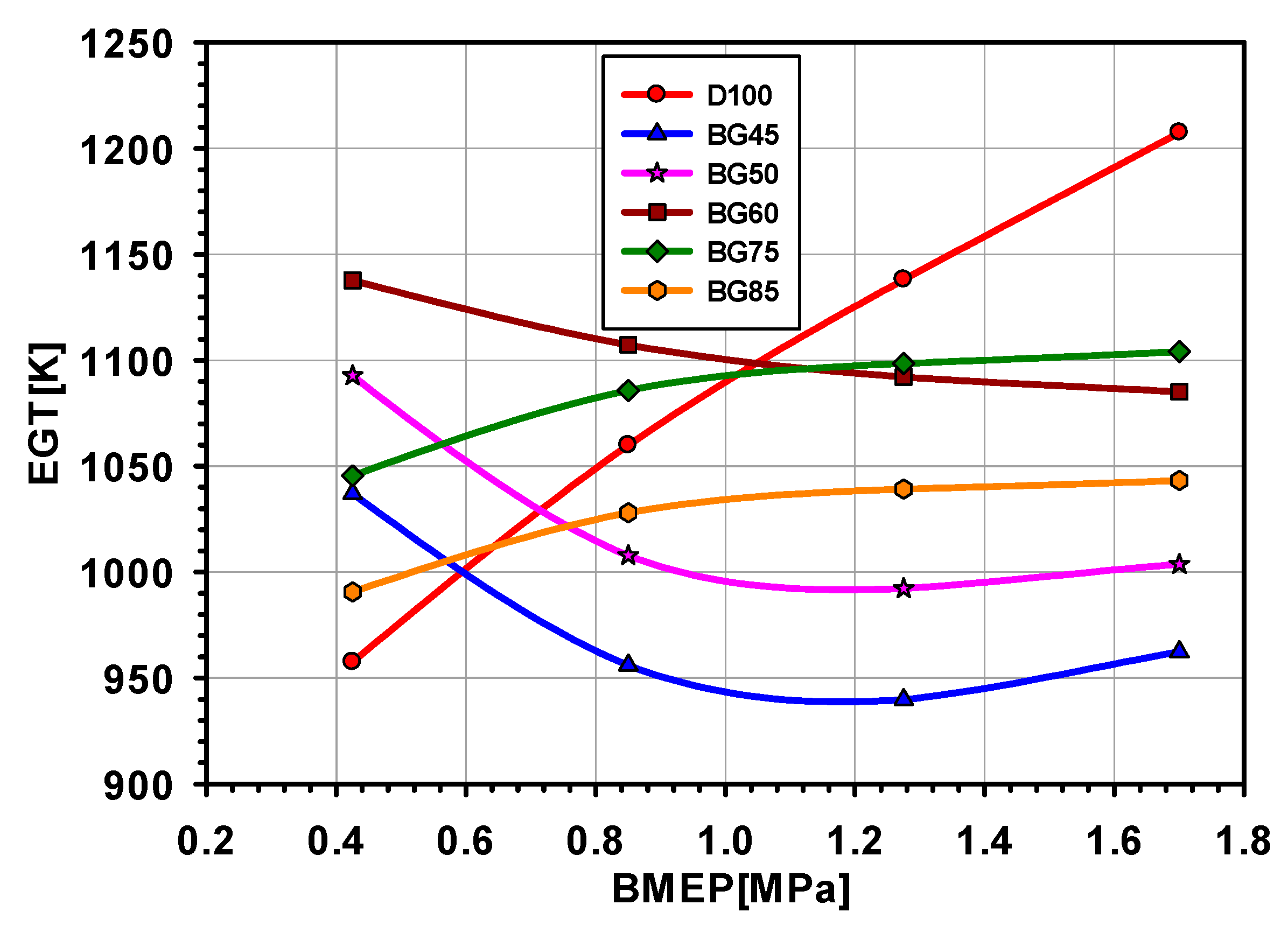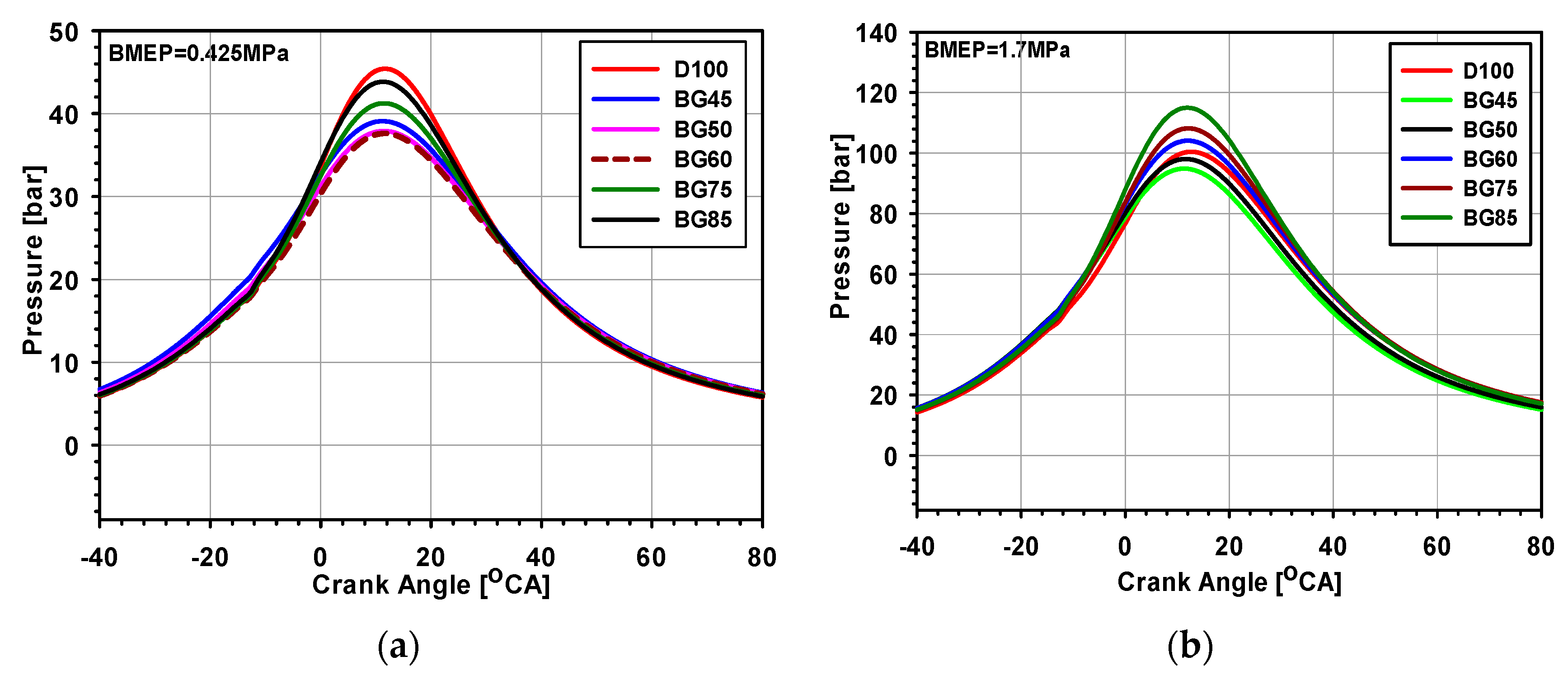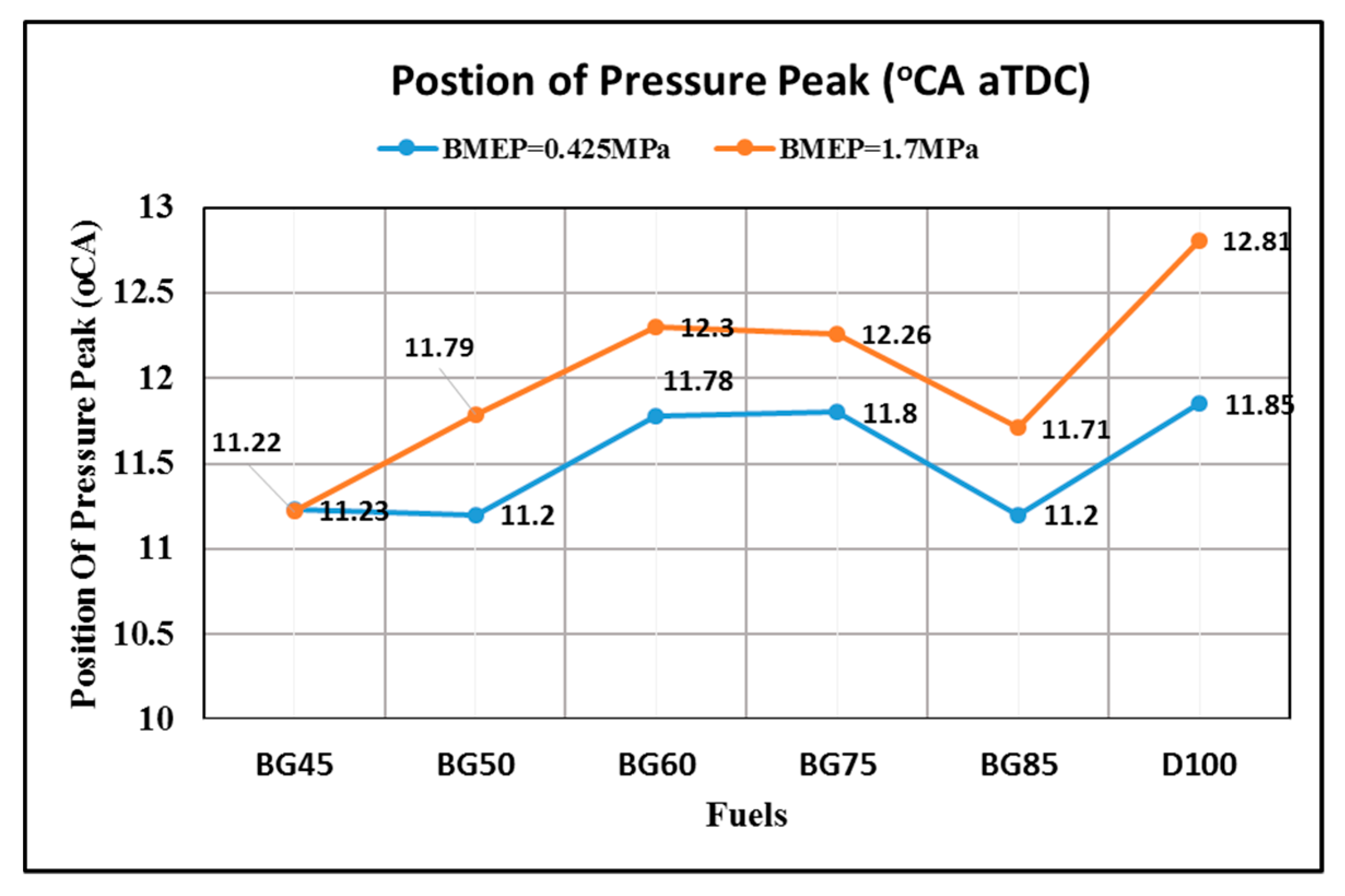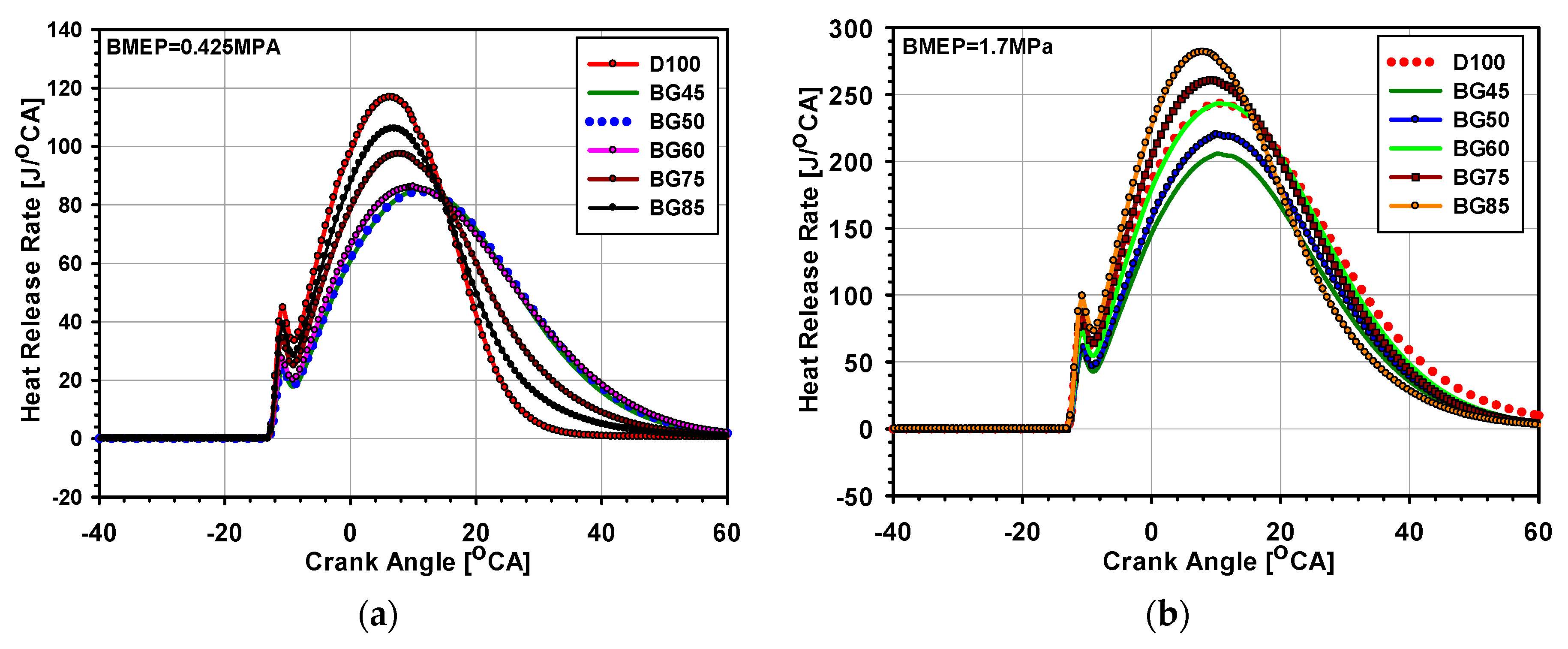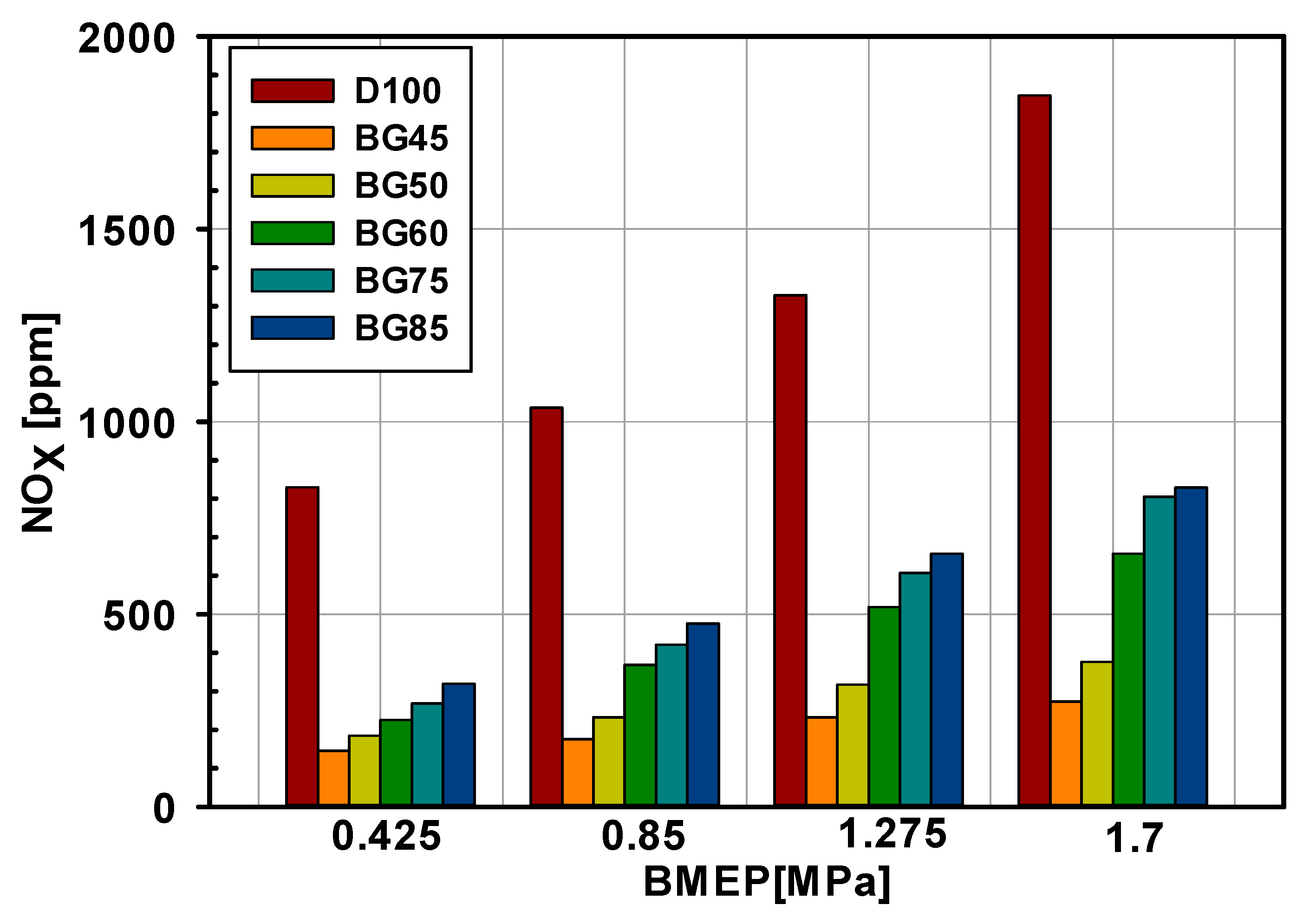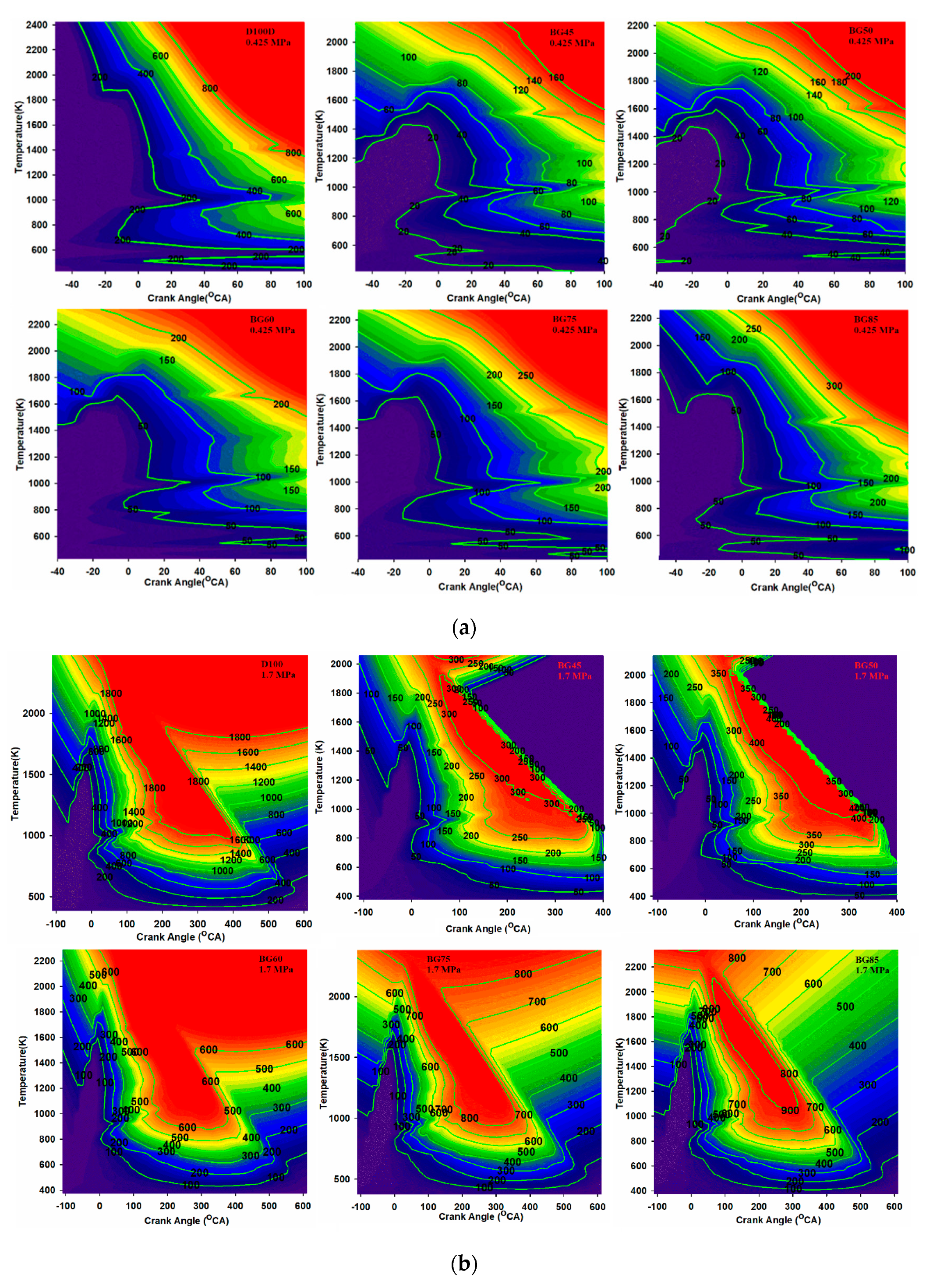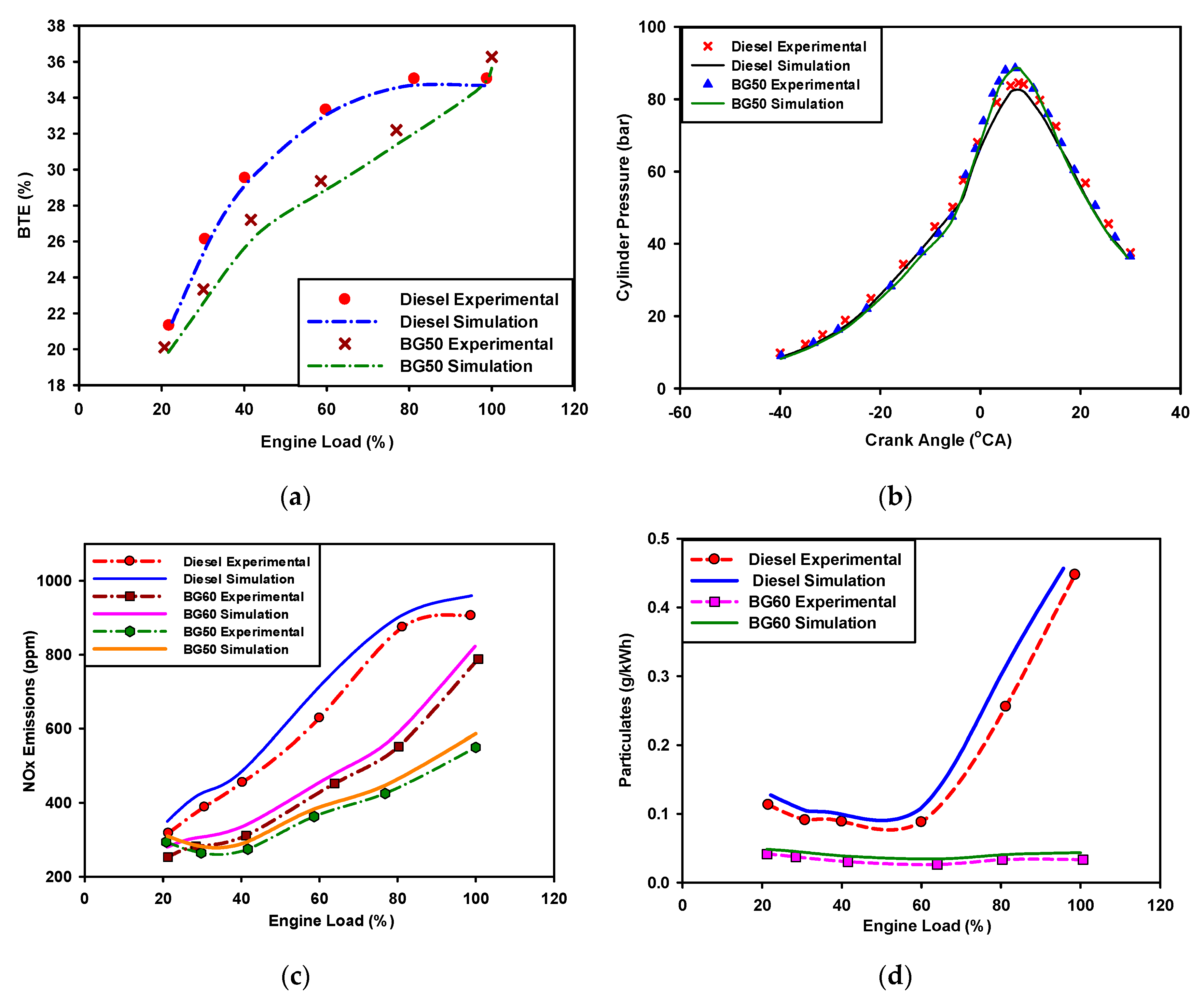1. Introduction
Due to their greater thermal efficiency, diesel engines play a key role in the world’s transport and industrial facilities [
1], in particular in heavy-duty systems such as lorries, buses, building and farm facilities, locomotives, vessels, etc. [
2]. Nonetheless, these engines emit greenhouse gases (GHG) pollutants such as methane (CH
4), carbon dioxide (CO
2), and carbon monoxide (CO) and have high pollutants of nitrogen oxides and smoke which results in a severe health hazards [
3]. The fossil fuels used by internal combustion (IC) engines add to the global environmental deterioration due to their GHG pollutants. Besides, due to the restrictions of reserves, supply, and higher demand for petroleum fuels induced by industrialization, prices of the fossil fuels are continually rising. Moreover, laws of diesel engine emissions have also been tightened [
4]. Renewed interest in renewable alternative fuels has been fostered due to the increased energy use, increasing prices of oil, diminishing oil reserves, and environmental pollution issues.
Many studies have been carried out to enhance combustion features so that engine effectiveness is maximized by reducing fuel consumption and dangerous emissions, in order to comply with harsh emission rules and regulations, increasing energy demands, and decreasing non-renewable fuel. One of the most attractive techniques for improving fuel efficiency and for reducing environmental emissions is the use of biofuels [
5]. Biofuels such as biogas, alcohol, and biodiesels [
6] have been given significant consideration due their renewable trend and their ability to reduce net carbon dioxide emission [
7]. Ge et al. [
8] used palm oil biodiesel blends to improve performance and investigated emission characteristics and their formation. Jamrozik et al. [
9] found that compressed gas burned with diesel fuel in a dual fuel engine greatly reduces CO
2 and CO pollutants. Using 500 mg/L carbon nanotube mixed with diesel fuel Markov et al. [
10] reduced smoke emissions by 57% at full load condition. In another study Cong Ge et al. [
11] using 20% of canola oil biodiesel fuel mixed with 80% of diesel fuel reduced emissions of CO, HC, and particulate matter (PM) at various engine loads and constant engine speed of 1500 rpm. Biofuel production contributes to improving local farming, reducing reliance on oil imports, and reducing emissions. In comparison to fossil fuels, biofuel production is spread more equally and can be produced at a minimum investment cost. For diesel engines, biodiesel, bio-alcohols, liquid biomass, and hydro-treated vegetable oils (HVO) are used as the partial substitute for conventional diesel fuel. Alcohols (for example, ethanol, methanol, and butanol) [
12], vegetable oils, animal fats, biodiesel, biogas, and LPG are getting a great deal of interest among alternative fuels [
13,
14,
15,
16,
17].
The broad ignition boundaries of gaseous fuels and their ability to create homogeneous mixtures made them attractive. Furthermore, the hydrogen to carbon proportion of gaseous fuels is large. Thus, when used in IC engines very small emissions are feasible [
18]. Diesel engines can function at greater compression, enabling them to use alternative fuels such as biogas with low energy content [
19]. Biogas (BG) is one such a fuel, which is a blend of gasses produced in the absence of air during biological disintegration of organic matter [
20]. It is a carbon neutral gaseous fuel, bringing about no new expansion of ozone harming substances to nature. The quality of biogas in terms of composition varies depending on biomass, precursors, additives, and the conversion process. CH
4 is the primary portion of biogas, and the extent shifts from feedstock to feedstock. It is composed mostly of CH
4 (50–70%) and CO
2 (25–50%), with low fractions of H
2 (1–5%), N
2 (0.3–3%), and hydrogen sulfide (H
2S) traces [
21]. Studies have indicated that biogas generated from organic waste represents a useful alternative to fossil fuels and can be utilized by CI engines as they are better able to mix with air and smooth burning nature [
22]. Besides, the use of biogas offers alternative energy sources and protects the environment against damaging greenhouse gasses [
23]. Biogas as a car fuel has major environmental benefit of significantly reducing greenhouse gas (GHG) emissions in the transport sector. Biogas powered cars may decrease CO
2 emissions by 75–200% compared with fossil fuels [
24]. When fluid residues are used as organic fertilizers (subsequent to mineral fertilizers), it can prevent emissions of CH
4 by landfilling or storing manure and further save GHGs [
25]. In the past few years there has been a great deal of research in the use of biogas in conventional spark ignition (SI) and compression ignition (CI) engines. Its high self-ignition temperature hinders it to be used directly in CI engines, however, it can be used in a CI engines in a dual fuel strategy [
18,
26].
Biogas combustion with diesel fuel can provide low emission combustion. Its low Cetane number being a gaseous fuel makes it suitable for CI engines in a dual fuel approach. The high anti-knock properties of biogas compared with regular fuel makes it an applicable fuel for dual-fuel engines. However, the presence of CO
2 reduces thermal efficiency due to prolonged ignition delay and decreased flame temperature [
27]. CO
2 could also impact the combustion process (burning velocity), which might result in incomplete combustion prompting HC discharges and reduced engine efficiency [
28]. Moreover, the CO
2 present has some negative influence towards some parameters such volumetric energy density, fuel conversion efficiency, and the combustion enthalpy [
29]. CO
2 behaves as a non-reactive gas and impacts the burning velocity of the in-cylinder charge, thereby resulting in inadequate burning, that may cause the increase of brake specific fuel consumption (BSFC) [
30]. Nathan et al. [
31] reported that the CO
2 in the biogas smothered the high rate of release which is common in homogeneous charge compression ignition (HCCI) engines. However, they found improved efficiency and low levels of NO
X and soot. In another study, Makareviciene et al. [
32] assessed the impact of CO
2 in biogas used in a diesel engine. Their findings revealed that lower emission levels were observed when the engine was run with the EGR system. Lounici et al. [
33] reported that the high proportion of CO
2 present in biogas significantly reduces NO
X and PM. Owczuk et al. [
34] found that biogas containing up to 50% CO
2 can be applicable as a tractor fuel.
A lot of studies have been carried out on the usage of biogas in a diesel engine in a dual fuel approach using biogas-diesel (BG-D), biodiesel-biogas (BD-BG), and diesel-biogas-hydrogen (D-BG-H). They have embraced different engines and fuel alteration to enhance the thermal efficiency and cut down the level of pollutants emanated from CI engines. A review of research works on the usage of biogas in CI engines are outlined and given in
Table 1.
As indicated by the research works above, biogas can be utilized as a fuel in CI dual-fuel engines without any engine modification. Moreover, these studies have demonstrated that biogas-diesel fuels improve the efficiency and reduce emissions. In spite of the fact that there are various investigations with biogas, they were focused on one, two, or four cylinder engines; there are few studies in the literature for the assessment of biogas in multi-cylinder turbocharged engines which use biogas generated from pig manure (PM) and corn straw (CS). As of now, published works in this field indicate limited outcomes on the impacts of biogas generated from PM and CS on engine performance and exhaust emissions of multi-cylinder engines. Thus, it is crucial to recognize such impacts so as to help in future engine design. This work showed improved engine performance and lower emissions using low grade biogas.
In perspective of the above setting, the target of the present work was to investigate the usage of biogas generated from PM and CS as well as enriched biogas to operate a six cylinder CI diesel engine under dual fuel approach with biogas (BG) as the primary fuel and diesel as the pilot fuel at various engine load conditions (0.425, 0.85, 1.275, and 1.7 MPa). The performance of the biogas-diesel fuels was compared to the reference diesel fuel.
2. Materials and Methods
The biogas used in this research was generated by co-digestion of pig manure and corn straw (197 g/L*D of PM and 19 g/L*D of CS of which 51% of VS (volatile solid) and 66% of TS (total solid)). A daily continuous load of 150 mL/day of mixed substrate raw material was conveyed to two continuous stirred tank reactor (CSTR) reactors (4.5 m
3 working volume) and co-digested in anaerobic environment to produce biogas as shown in
Figure 1a. The biogas flow rate from each reactor was measured by a digital gas flow meter which is connected to a computer. Agilent 7890 A gas chromatograph (GC-7890A, Agilent Technology, Santa Clara, CL, USA) (
Figure 1b) fitted with a thermal conductivity detector (TCD) and helium as the carrier gas was used to measure the CH
4-CO
2 content in the biogas. The CO
2 percentage in biogas was intermittently measured using a Fyrite gas analyzer (Bacharach Inc.) as per the method indicated by the maker.
Figure 2a depicts the daily biogas output with respect to the digestion time. The average everyday biogas generation during the 110 day digestion time was observed to be 2000 mL/day per kg of PM (pig manure) and CS (corn straw).
Figure 2b depicts the percentage of CH
4 and CO
2 over 110 days of the digestion period. We were able to produce a 0.06 m
3 biogas from 1 kg of pig manure biomass.
2.1. Overview of the Model
The model deployed for this research is turbocharged, has six cylinders, and a direct injection engine. The model is depicted in
Figure 3 and engine parameters are given in
Table 2. The model consisted of an intercooler unit, turbocharger unit, a biogas cylinder, throttle valve that controls the mass flow rate of the air–biogas mixture and a high-pressure fuel injection system (injector with eight holes and 0.25 mm diameter). The engine control unit (ECU) regulated the injection system, the main engine variables (engine speed, crank angle, and mass flow of fuel and air). Performance and exhaust emission were recorded at a fixed engine speed of 1800 rpm and four loads of BMEP 0.425, 0.85, 1.275, and 1.7 MPa.
The present work was carried out with 1D simulation software GT-Power 7.4 version which is commonly used for the modeling and assessment of engines and is based on thermodynamic analyses. Geometrical input information (discharge coefficient and valve lift count) for the valves, pipes, and cylinders were used as input data for modeling the engine. The engine working parameters, such as surrounding conditions, injection timing, and engine speed, were also used as input information. The compressor and the turbine chart defined the turbocharger’s output. The boost pressures were kept up at 1.1, 1.75, 1.9, and 1.9bar corresponding to 0.425, 0.85, 1.275, and 1.7 MPa of BMEP.
2.2. Fuels
Diesel, biogas generated from pig manure and corn straw, and enriched biogas were used as fuels. The biogas was generated from pig manure and corn straw as explained above. After the data was analyzed, three different compositions of biogas with methane percentages of 45%, 50%, and 60% were selected for this study. The properties of the biogas with different compositions were determined and used in the engine numerical model. The biogas was then enriched so that the percentage of methane increased to 75% and 85% (by vol.). The fuels used are designated as follows, BG45 refers to 45% methane gas and 55% CO
2 by volume, BG50 refers to 50% methane gas and 50% CO
2 by volume, BG60 refers to 60% methane gas and 40% CO
2 by volume, BG75 refers to 75% methane gas and 25% CO
2 by volume, BG85 refers to 85% methane gas and 15% CO
2 by volume, and D100 refers to neat diesel fuel. The properties of diesel and biogas are summarized in
Table 3. The mass of the injected pilot diesel fuel is depicted in
Figure 4.
Simulations were conducted in order to analyze the impacts of the different compositions of biogas on engine performance and emission. The engine was run at a constant speed of 1800 rpm at various brake mean effective pressures (BMEP) of 0.425, 0.85, 1.275, and 1.7MPa, respectively. Initially, simulations of diesel (single fuel) were performed at four different loads to generate reference data, then further simulations for biogas fuels (15% up to 55% CO2 by vol.) were performed using diesel as pilot fuel in dual-fuel mode.
